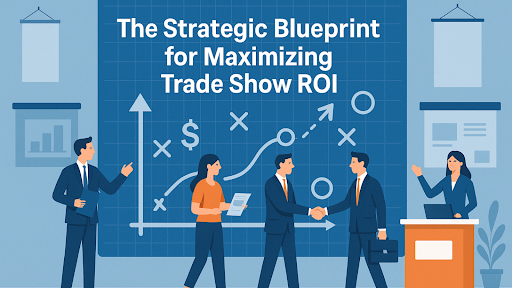The Strategic Blueprint for Maximizing Trade Show ROI

Los Angeles is a global metropolis with an innovative spirit. Its strategic geographic location, and world-class infrastructure make it a powerhouse in international trade. If you want to grow and expand your business in this vibrant business ecosystem, you should not skip trade shows in Los Angeles.
Whether you are exhibiting in this city or any other business hub, you need to invest significant time, money and resources in trade shows. Your investment is at risk if you approach a trade show exhibition without a strategic blueprint. Strategic planning distinguishes a transformative event from a mediocre one. To create an inviting presence, count on trade show exhibition companies for trade show booth design in Los Angeles. And, when it comes to developing a winning strategy, this definitive guide will be your roadmap to success.
The High Cost of Neglecting Strategy
Depending on the booth space, design, travel, and staffing, you may have to invest around $50,000 to exhibit at a trade show. However, many exhibitors participate without clear, measurable goals. Lack of strategy means missed connections, brand ambiguity and wasted budget.
Lack of pre-show outreach, vague product demos, and poor post-event follow-up can result in zero sales.
Align Trade Shows with Core Business Objectives
How will this show move your business forward? It’s an important question. Your goals and strategy must align with the trade show’s audience, opportunities, and potential ROI.
| Business Goal | Trade Show Strategy |
| Entering a new market | Partner with local influencers and host workshops to educate attendees. |
| Launching a Product | Host live demos and offer discounts in return for contact details. |
| Strengthening Client Relationships | Schedule VIP dinners and provide personalized consultation. |
Integrate Trade Shows into Your Marketing Ecosystem
Trade shows shouldn’t exist in a silo. Treat it as an essential component of your broader marketing strategy.
Pre-Show Tactics
6 to 8 weeks before the event, focus on the following:
Targeted Promotion
Segment your target audience by industry, job title and interest. Use tailored LinkedIn ads to target each segment. Send personalized email invites to high-priority prospects.
Content Hooks
If you are planning to launch a product, use countdowns to create buzz online. Write blog posts previewing key discussion topics from your upcoming roundtable.
On-Site Amplification
Don’t limit your impact to physical attendees. Stream live product demos and panel discussions on platforms like LinkedIn or Instagram to multiply your reach.
Post-Show Momentum
Timely, relevant follow-up transforms booth conversations into closed deals. However, a simple thanks-you email will not work. Personalize your communication and recap key event insights. Invite prospects to a webinar.
Craft a Hyper-Targeted Event Strategy
Precision Targeting
Decision-makers and end-users have different pain points. You need segmented messaging. For example, focus on ROI and scalability when targeting decision-makers. End users are more interested in features and ease of use.
Booth Experience Design
Create a central demo area and private meeting pods for serious talks. Use AR demos to allow visitors to “try” your offerings right at your booth. QR codes can quickly collect and save leads to HubSpot or Salesforce.
Leverage Technology for Precision & Efficiency
Use lead retrieval tools to auto-score leads. You can score leads depending on engagement. Track real-time scan rates, demo attendees and other metrics to adjust your trade show strategy.
Post-Show Evaluation: From Data to Action
The following are the essential KPIs you must track:
- Lead conversion rate
- Cost per lead
- Average time spent at booth/demo
Compare trade show results against your SMART goals. Using surveys to get feedback from attendees can help you refine your trade show strategy. You should also analyze the tactics of top performers at the trade show.

Comments are closed.